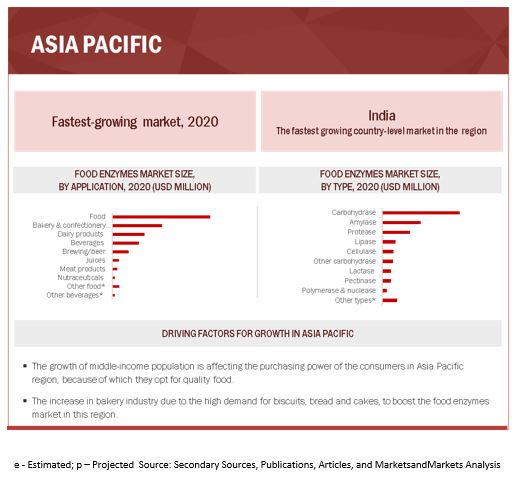According to MarketsandMarkets, the food enzymes market is estimated to be valued at USD 2.2 billion in 2021 and is projected to reach USD 3.1 billion by 2026, recording a CAGR of 6.4%, in terms of value. The growing environmental concerns, urbanization, increasing disposable income and advancements in R&D activities led to the growth of the food enzymes market. In addition, the advancements in technology such as enzyme engineering and the introduction of genetically engineered enzymes have boosted the growth of food industry. Factors such as the multifunctional benefits of food enzymes across various applications and the technological innovations to reduce the consumption of chemicals contribute to the growth of the food enzymes market.

Report Objectives:
- To describe and forecast the food enzymes market, in terms of type, source, application, formulation, and region
- To describe and forecast the food enzymes market, in terms of value, by region–North America, Europe, Asia Pacific, and South America—along with their respective countries
- To provide detailed information regarding the major factors influencing the market growth (drivers, restraints, opportunities, and challenges)
- To strategically analyze micro-markets with respect to individual growth trends, prospects, and contributions to the overall market
- To study the complete value chain of the food enzymes market
Download PDF Brochure: https://www.marketsandmarkets.com/pdfdownloadNew.asp?id=800
The microorganism segment is projected to witness significant growth during the forecast period.
Based on source, the food enzymes market is segmented into microorganism, plant, and animal. The microorganism segment is projected to witness the fastest growth during the forecast period, as enzymes obtained from microbial sources lead to low production costs and are stable than other sources. They can be produced through fermentation techniques in a cost-effective manner with less time and space requirement, and because of their high consistency, process modification and optimization are easily done.
The carbohydrases segment is projected to account for a major share in the food enzymes market during the forecast period
By type, the food enzymes market is segmented into carbohydrases, proteases, lipases, polymerases & nucleases, and other enzymes (such as catalases, laccases, oxidases, phosphatases, kinases, esterases, and pectinases). Carbohydrases are classified into amylases, cellulases, and other carbohydrases (such as pectinases, lactases, mannanases, and pullulanases). Amylase is used in the baking industry as the addition of amylase to the dough, enhances the fermentation rate which results in the reduction of the viscosity of dough, further improving the volume and texture of the product. Due to easy modification and optimization processes, there is a huge usage of amylase in the food & beverage industry.
Speak to Analyst: https://www.marketsandmarkets.com/speaktoanalystNew.asp?id=800
Asia Pacific is projected to grow at highest CAGR during the forecast period
The increasing purchasing power of consumers due to the economic development in APAC countries has led to an increase in the demand for high-quality processed food. Hence, due to their characteristics as essential healthy food additives, the market for enzymes in food & beverages is projected to grow. The changes in consumer preferences and liberalization of trade have further fueled the demand for foods like meat and meat products in the country.
Key Market Players:
Key players in the food enzymes market include DuPont (US), Associated British Foods plc (UK), DSM (Netherlands), Novozymes (US), and Kerry Group (Ireland), Advanced Enzyme Technologies Ltd (India), Amano Enzyme Inc. (Japan) and CHR. Hansen Holdings A/S (Denmark). These major players in this market focus on increasing their presence through expansions, mergers & acquisitions, partnerships, joint ventures, and agreements. These companies have a strong presence in North America, Asia Pacific, and Europe. They also have manufacturing facilities, along with strong distribution networks across these regions.